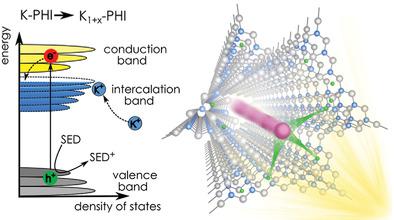当前位置:
X-MOL 学术
›
Adv. Energy Mater.
›
论文详情
Our official English website, www.x-mol.net, welcomes your feedback! (Note: you will need to create a separate account there.)
Optoelectronics Meets Optoionics: Light Storing Carbon Nitrides and Beyond
Advanced Energy Materials ( IF 27.8 ) Pub Date : 2020-11-23 , DOI: 10.1002/aenm.202003049 Filip Podjaski 1 , Bettina V. Lotsch 1, 2
Advanced Energy Materials ( IF 27.8 ) Pub Date : 2020-11-23 , DOI: 10.1002/aenm.202003049 Filip Podjaski 1 , Bettina V. Lotsch 1, 2
Affiliation

|
Known for decades, Liebig's carbon nitrides have evolved into a burgeoning class of macromolecular semiconductors over the past 10+ years, front and center of many efforts revolving around the discovery of resource‐efficient and high‐performance photocatalysts for solar fuel generation. The recent discovery of a new class of “ionic” 2D carbon nitrides—poly(heptazine imide) (PHI)—has given new momentum to this field, driven both by unconventional properties and the prospect of new applications at the intersection between solar energy conversion and electrochemical energy storage. In this essay, key concepts of the emerging field of optoionics are delineated and the “light storing” ability of PHI‐type carbon nitrides is rationalized by an intricate interplay between their optoelectronic and optoionic properties. Based on these insights, key characteristics and general principles for the de novo design of optoionic materials across the periodic table are derived, opening up new research avenues such as “dark photocatalysis”, direct solar batteries, light‐driven autonomous systems, and photomemristive devices.
中文翻译:

光电与光电相遇:光存储碳氮化物及其他
在过去的10多年中,Liebig的碳氮化物已发展成为新兴的大分子半导体,这是许多努力的前沿和中心,其重点是发现用于太阳能燃料的资源高效和高性能光催化剂。近期发现的新型“离子”二维碳氮化物-聚(庚嗪酰亚胺)(PHI)已为该领域注入了新的动力,这是由非常规性能和太阳能转换之间的交汇处的新应用前景推动的和电化学储能。在本文中,描述了光电子学新兴领域的关键概念,并通过其光电性质与光电子性质之间的复杂相互作用来合理化PHI型碳氮化物的“光存储”能力。基于这些见解,
更新日期:2021-01-27
中文翻译:

光电与光电相遇:光存储碳氮化物及其他
在过去的10多年中,Liebig的碳氮化物已发展成为新兴的大分子半导体,这是许多努力的前沿和中心,其重点是发现用于太阳能燃料的资源高效和高性能光催化剂。近期发现的新型“离子”二维碳氮化物-聚(庚嗪酰亚胺)(PHI)已为该领域注入了新的动力,这是由非常规性能和太阳能转换之间的交汇处的新应用前景推动的和电化学储能。在本文中,描述了光电子学新兴领域的关键概念,并通过其光电性质与光电子性质之间的复杂相互作用来合理化PHI型碳氮化物的“光存储”能力。基于这些见解,



























 京公网安备 11010802027423号
京公网安备 11010802027423号